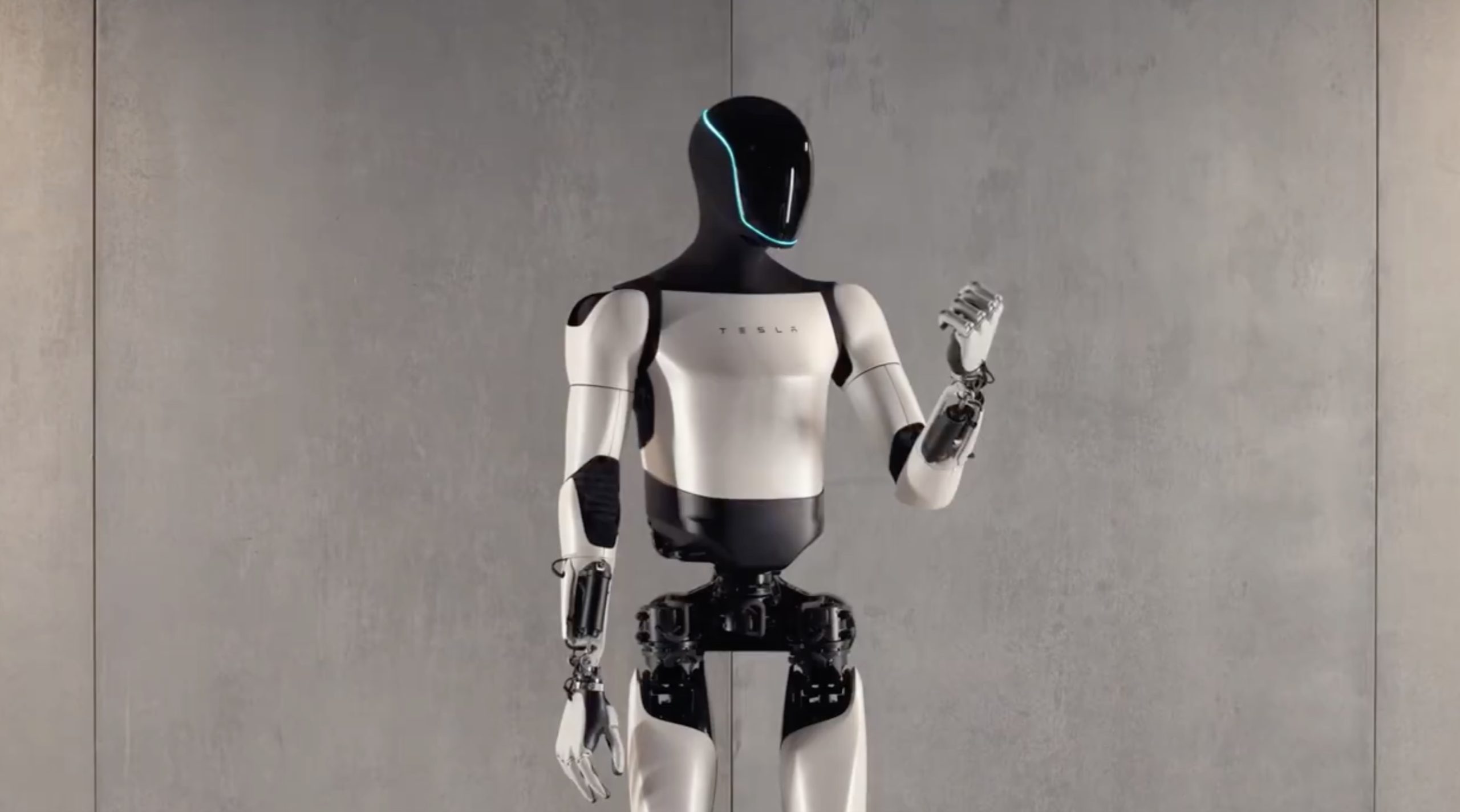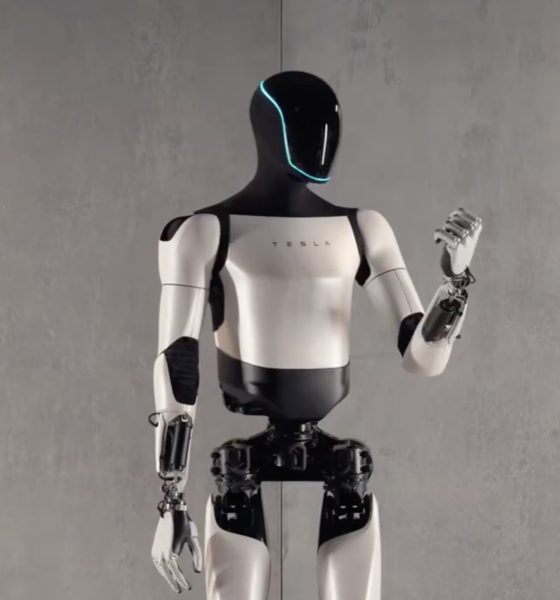Tesla has posted an update to its Optimus program on X, and it is extremely impressive. Over the course of a short video, Tesla showcased the Gen 2 Optimus prototype, which features an updated design, almost humanlike hand movements, and a lighter weight compared to its previous iterations.
In its short demonstration, the Gen 2 Optimus robot could be seen moving its neck and arms like a human being. Tesla noted that the robot features custom-designed actuators and sensors, as well as a 2-DoF actuated neck. The robot features a 30% walking speed boost from its previous iteration, and it is also 10 kg lighter.
There’s a new bot in town ?
Check this out (until the very end)!https://t.co/duFdhwNe3K pic.twitter.com/8pbhwW0WNc— Tesla Optimus (@Tesla_Optimus) December 13, 2023
It also boasts better balance and control, and it is equipped with faster, 11-DoF hands with tactile sensing on all fingers. Tesla demonstrated the Gen 2 Optimus robot’s hand control by having the robot handle an egg in the video. Tesla ended its video with a couple of Gen 2 Optimus robots dancing to some music — quite impressively, all things considered.
Everything in this video is real, no CGI. All real time, nothing sped up. Incredible hardware improvements from the team. https://t.co/y5QNYaZy0M— Julian Ibarz (@julianibarz) December 13, 2023
So smooth were the movements of Gen 2 Optimus in its demonstration that members of the Tesla Bot team have taken to social media to clarify that the footage is real and not CGI. The Tesla Bot team members also highlighted that the robots’ movements in the video were recorded in real-time, not sped up.
Excited to share our latest bot ! Amazing new platform to build the future of humanoid robotics upon. Very proud of the teams who've all been hard at work to get this to happen 🙂
This new generation, which is in effect the 3rd since we started the program less than 2 years ago,… https://t.co/k2kGFsXUuu— Milan Kovac (@_milankovac_) December 13, 2023
The capabilities of the Gen 2 Optimus robot are very impressive, especially considering the fact that Tesla’s humanoid robot program is just over two years old now. Tesla announced its intentions to build a humanoid robot at its first AI Day event in August 2021, and at the time, all the company had was a static model and a man in a robot suit dancing onstage.
Multiple fully Tesla-made Bots now walking around & learning about the real world ?
Join the Tesla AI team → https://t.co/dBhQqg1qya pic.twitter.com/3TZ2znxkfd— Tesla Optimus (@Tesla_Optimus) May 16, 2023
To be fair, the rapid progress of Tesla’s Optimus program was already evident since AI Day 2.0., which was held in September 2022. At the time, Tesla was able to show a development prototype called “Bumblebee,” which was built with off-the-shelf parts, walking on its own without human assistance. The company also revealed a more advanced Optimus robot that’s equipped with Tesla-designed actuators and sensors.
Optimus can now sort objects autonomously ?
Its neural network is trained fully end-to-end: video in, controls out.
Come join to help develop Optimus (& improve its yoga routine ?)
→ https://t.co/dBhQqg1qya pic.twitter.com/1Lrh0dru2r— Tesla Optimus (@Tesla_Optimus) September 23, 2023
The more advanced Optimus prototype, named “Gen 1 Optimus” in Tesla’s recent video announcement, featured smoother movements than “Bumblebee,” but it could not stand on its own feet yet. By May 2023, however, Tesla posted a video on X showing the Gen 1 Optimus walking on its own, and on September 2023, the robot was sorting objects by color. It could even do some yoga moves that required quite a bit of balance.
Don’t hesitate to contact us with news tips. Just send a message to simon@teslarati.com to give us a heads up.

Elon Musk
Elon Musk just said some crazy stuff about the Tesla Roadster

Elon Musk appeared on the Moonshots podcast with Peter Diamandis today to discuss AGI, U.S. vs. China, Tesla, and some other interesting topics, but there was some discussion about the upcoming unveiling of the Roadster, the company’s electric supercar that will arrive several years after it was initially slated for release.
Musk made some pretty amazing claims about the Roadster; we already know it is supposed to be lightning-fast and could even hover, if Tesla gets everything to happen the way it wants to. However, the car has some pretty crazy capabilities, some of which have not even been revealed.
On the podcast, Musk said:
“This is not a…safety is not the main goal. If you buy a Ferrari, safety is not the number one goal. I say, if safety is your number one goal, do not buy the Roadster…We’ll aspire not to kill anyone in this car. It’ll be the best of the last of the human-driven cars. The best of the last.”
🚨 Elon on the Roadster unveiling, scheduled for April 1:
— TESLARATI (@Teslarati) January 6, 2026
Musk makes a good point: people who buy expensive sports cars with ridiculous top speeds and acceleration rates do not buy them to be safe. They hope they are safe in case of an emergency or crash, but safety is not at the forefront of their thoughts, because nobody buys a car thinking they’ll crash it.
The Roadster is truly going to push the limits and capabilities of passenger vehicles; there’s no doubt about that. Tesla plans to show off the new version car for the first time on April 1, and Musk has only hinted at what is possible with it.
Musk said back in November:
“Whether it’s good or bad, it will be unforgettable. My friend Peter Thiel once reflected that the future was supposed to have flying cars, but we don’t have flying cars. I think if Peter wants a flying car, he should be able to buy one…I think it has a shot at being the most memorable product unveiling ever. [It will be unveiled] hopefully before the end of the year. You know, we need to make sure that it works. This is some crazy technology in this car. Let’s just put it this way: if you took all the James Bond cars and combined them, it’s crazier than that.”
Production is set to begin between 12 and 18 months after the unveiling, which would put the car out sometime in 2027. Hopefully, Tesla is able to stay on track with the scheduling of the Roadster; many people have been waiting a long time for it.
News
Tesla launches hiring for Robotaxi program in its twentieth country
Overall, the hiring signals Tesla’s aggressive timeline for global dominance in autonomous mobility.

Tesla has launched a hiring initiative for its Robotaxi program in its twentieth country, as the company posted two new jobs in Thailand this week.
Tesla is hiring in Bangkok and Kowloon for the Vehicle Operator position, which is related to data collection, and is the first in Thailand, but the twentieth country overall, as the company tries to expand into other markets.
🚨 BREAKING: Tesla is hiring additional full-time Vehicle Operators in Bangkok, Thailand.
Previous openings were 6-month, part-time roles. These are equivalent to AI Safety Operator roles in the U.S. pic.twitter.com/R6LzoU1bos— Tesla Yoda (@teslayoda) January 5, 2026
Tesla has had active job postings for Vehicle Operator positions in the United States, India, Israel, Taiwan, Germany, the Czech Republic, Hungary, the UK, Finland, Switzerland, Sweden, the Netherlands, Austria, Spain, Norway, Italy, and Turkey in past listings.
These postings are not all currently available, likely because the roles have been filled.
Thailand is the most recent, and broadens the company’s potential path to expanding its ride-hailing program, which is only active in the United States in Austin, Texas, and the California Bay Area, so far.
These roles typically involve data collection, which assists in improving Autopilot and Full Self-Driving operation. Tesla’s self-driving programs utilize real-world data that is accumulated and stored, observing vehicle and traffic behavior, as well as tendencies that are performed by human drivers to help increase safety and overall performance.
Overall, the hiring signals Tesla’s aggressive timeline for global dominance in autonomous mobility. Although the company has several high-profile rivals and competitors in the field, it has established itself as a main player and a leader in the development of autonomous technology, especially in the U.S., as its FSD suite is refined on almost a weekly basis.
The Full Self-Driving suite is available in seven countries and territories currently, including the U.S., Canada, China, Mexico, Puerto Rico, Australia, and New Zealand. Its biggest goal for expansion is currently the European market, where regulatory hurdles have been the main bottleneck prolonging its launch on the continent.
Tesla has performed months of testing in various European countries, including France and Spain, and does have support in some areas from various regulatory agencies. However, the company is hoping to get through this red tape and offer its suite in Europe for the first time, hopefully this year.
News
Tesla China rolls out Model Y upgrades, launches low-interest financing
These strategies are aimed at improving the ownership experience and keeping vehicle pricing competitive in the world’s largest electric vehicle market.

Tesla has rolled out minor updates to the five-seat Model Y in China, upgrading the vehicle’s center display to a higher-resolution 16-inch 2K screen. The electric vehicle maker also introduced attractive financing options, including 7-year low-interest rates, to offset the new purchase tax on EVs.
These strategies are aimed at improving the ownership experience and keeping vehicle pricing competitive in the world’s largest electric vehicle market.
Five-seat Model Y gets larger, better display
With its recent update, all three variants of the five-seat Model Y now feature an upgraded 16-inch 2K resolution center display, which replaces the vehicle’s previous 15.4-inch 1080p panel. This screen was already used in the six-seat Model Y L, and it offered improved visual clarity. Tesla China has also updated the Model Y’s headliner to black, giving the vehicle a sleeker appearance.
Prices of the five-seat Model Y remain unchanged at RMB 263,500, RMB 288,500, and RMB 313,500 for the respective trims. This update enhances the cabin experience as domestic rivals are already adopting high-resolution screens. As noted in a CNEV Post report, some domestic automakers have begun rolling out vehicles equipped with 3K-resolution displays.
New financing offers
Tesla also launched ultra-long-term financing offers for its locally produced models in China, which include the Model 3 sedan, the five-seat Model Y, and the six-seat Model Y L, through January 31, 2026. The 7-year option features an annualized fee rate as low as 0.5%, which is equivalent to 0.98% interest. This is expected to save customers up to RMB 33,479 ($4,790) compared to standard rates.
A 5-year zero-interest plan is also available, and it has been extended to the Tesla Model Y L for the first time. These incentives help offset China’s new 5% purchase tax on New Energy Vehicles (NEVs) in 2026-2027. Some of Tesla’s rivals in China have announced in recent months that they would be covering the purchase tax owed by buyers early this year.










